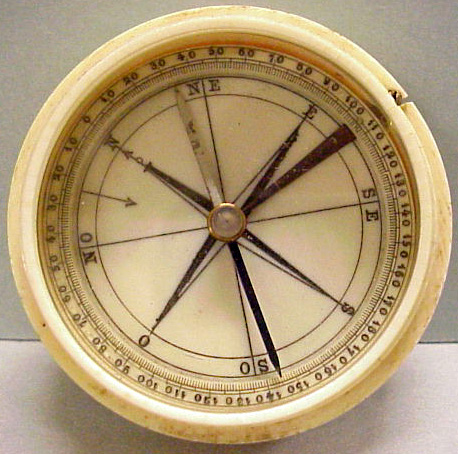For August’s Artifact of the Month, we will be looking at a series of compasses that we have here at The Mariners’ Museum. The compass is one of the world’s oldest navigational instruments, dating back to the Chinese between the 9th and 11th centuries. A magnetic compass works by aligning its magnetic needle with the Earth’s magnetic North Pole, and therefore ensuring that it always points north. The compass was created from the use of lodestones, which is a mineral with a magnetized iron ore. The Chinese found that when put flat on a board, the lodestones would continue to consistently point in the same north and south direction. The compass hugely improved the accuracy of maritime exploration and travel. It made it much easier to locate destinations, and cut time off of traveling. With the aid of other devices, the compass can also be utilized to figure out both longitude and latitude. It also made it so that areas known to be problematic to navigate were much easier to avoid or move through. This helped revolutionize maritime travel, making it easier for explorers to go on longer expeditions as well as safer ones.

One of our most beautiful compasses in our collection is one that was purchased by Fred Hill in Paris, France. It is only about two and half inches in diameter, and has an ivory case that opens and closes much like a woman’s compact. It’s dated to between 1750 and 1850, though the exact date and maker is unknown. There is another compass in our collection hidden in the hold here at The Mariners’ Museum that was also purchased by Fred Hill. This one is a miniature compass, which is also by an unknown French maker (perhaps the same unknown maker!). This compass is thought to have maybe been a toy, and is set in a brass bowl on a bone stand. This miniature compass is thought to be from 1910. This miniature compass is pictured below, while the compact compass is pictured above.

Little is known about Fred Hill, other than he had an apparent liking for compasses. A third compass in our collection is a fisherman’s compass that was also acquired by Hill in Paris. It has an octagonal shaped box, with a glass top and brass ring. This one is thought to have been made by P. Luce, of Granville, France, but the box could not be opened for closer inspection of the maker’s insignia. All three compasses were acquisitioned into The Mariners’ Museum collection in May 1937, and are beautiful representations of such an importance instrument of maritime history.